I’ve been thinking a lot about bodies and strength and power and how we look vs. how we feel and what it means to love yourself, so I distilled all that thinking into a little autobio comic. It’s been a slow, fascinating journey to where I’m at now, and I’m far from finished. It’s just good to feel a change. Enjoy!
Author: Lucy Bellwood
If you follow me elsewhere on social media, you know I’ve got a massive penchant for drawing challenges. Inktober is a perennial favorite, so this year I tackled 31 6×6″ watercolor paintings of sunrises and sunsets. Each image was painted from life wherever I happened to be on each day of the month, starting with a basic silhouette of the sky at dusk or dawn.

The final result spanned Portland, Long Beach (WA), New York, and Richmond, and looked something like this:
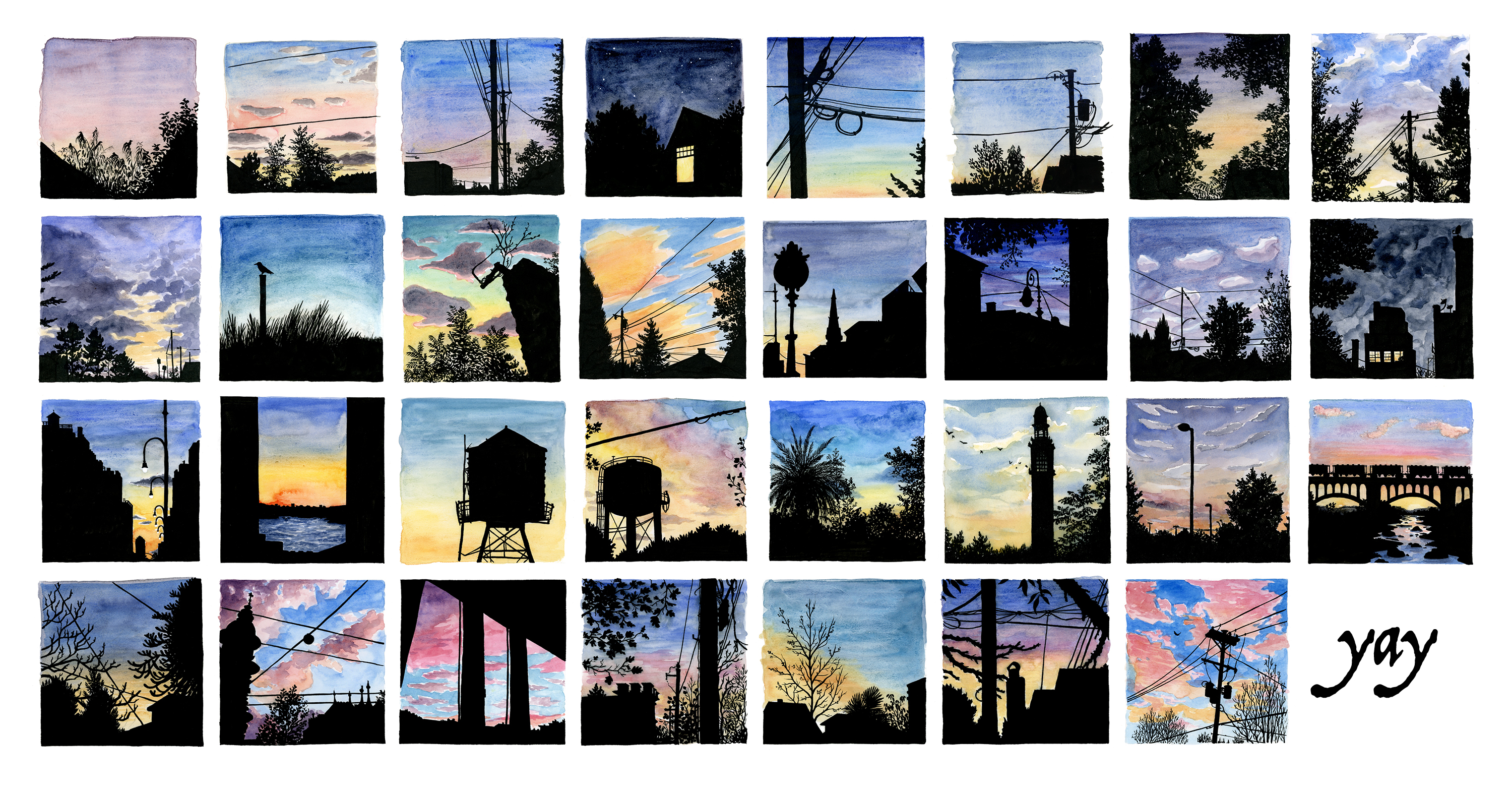
While prints of all these images are available in my online shop right now, I’ve also decided to sell off the original paintings themselves to help raise some end-of-year cash to help with book printing in 2018.
Buyolympia will be listing the originals (unframed) in batches of 5 over the next few weeks every Tuesday and Thursday. If there’s one you’ve got your eye on, be prepared to act fast! The framed pieces that pre-sold at Portland’s tiny llama gallery earlier this week went real quick.

You can check out the current selection at Buyolympia and take advantage of their free shipping promotion to snag some other gifts for the holiday season while you’re at it. Happy shopping!
This is it, everyone! It’s Day Seven of Inner Critic Investigation Week, the writing prompt series I’ve been collaborating on with writing coach Deb Norton.
The rules are as follows:
- Get a pen and a sheet of paper.
- Set a timer for six minutes.
- WRITE. Ask your Inner Critic the question and find out what they have to say. Keep your pen moving, even if you’re writing lies or “Blah blah blah” over and over.
Our seventh and final prompt is:
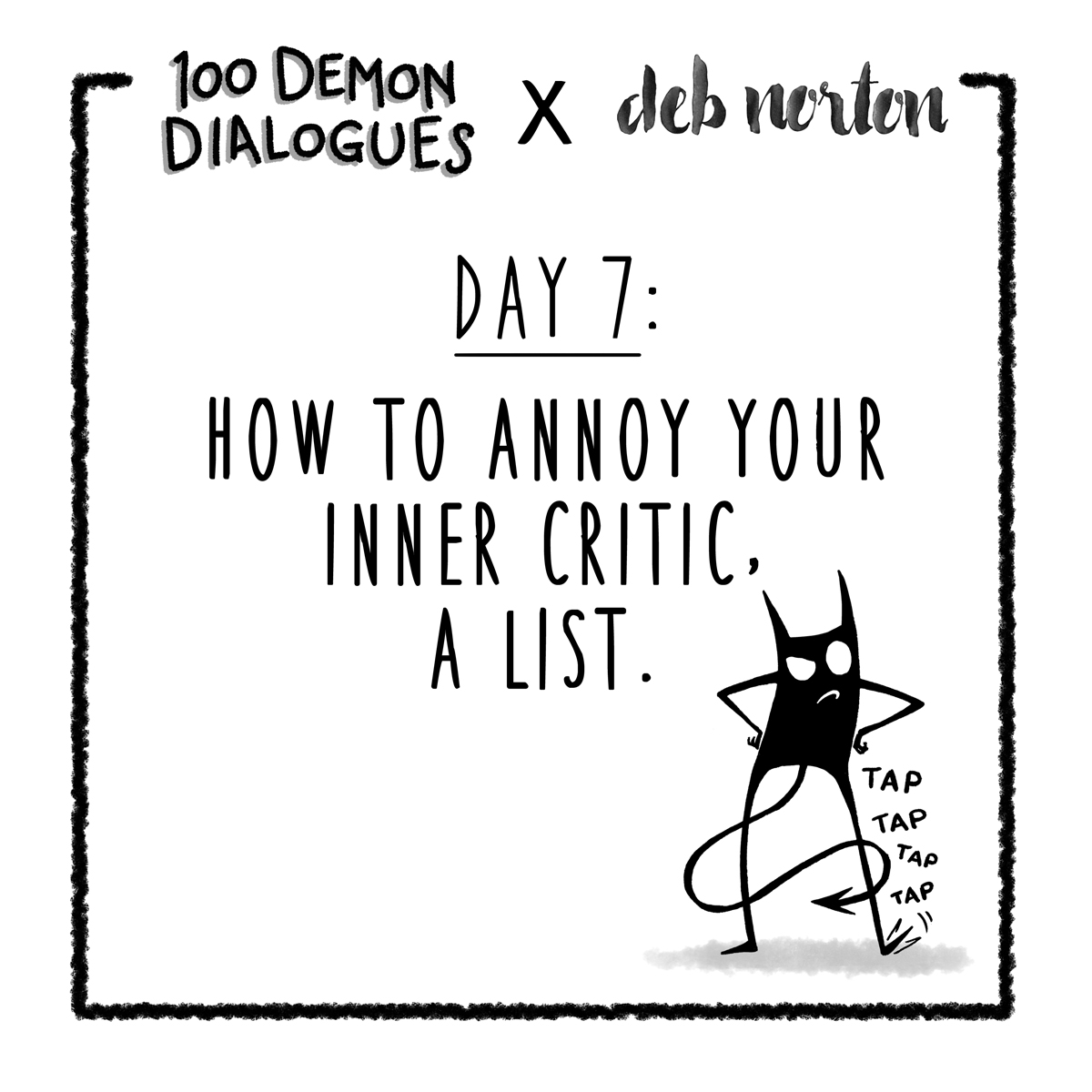
By now you’ve probably got a pretty good idea of what your Inner Critic doesn’t like. What happens if you deliberately try to push their buttons? Make a list of everything you can think of that will make your Critic hoppin’ mad. Maybe it’s doing a deliberately horrible drawing. Maybe it’s singing loudly in the shower when that voice inside is screaming at you to be quiet because the neighbors will judge you. Maybe it’s eating a whole pizza in one sitting. There are no wrong answers, just list as many things as you can think of.
I’d love to do a round-up post next week with some anonymous entries from various people’s writing exercises. If you’d be willing to share, email me some excerpts at lucypcbellwood@gmail.com, or leave ’em in the comments below.
Thank you so much for following along with this experiment! If you’d like to learn more about Deb’s work, check out her website or buy a copy of Part Wild: a Writer’s Guide to Harnessing the Creative Power of Resistance. You can also listen to the podcast we recorded about Inner Critics and the creative process. The little character you see featured in all these prompts is my Inner Critic, who I got to know over the course of drawing 100 comics in 100 days. You can read those right here.
It’s Day Six of the Inner Critic Investigation series I’m collaborating on with writing coach Deb Norton! Our goal is to help you develop a dialogue with your Inner Critic as if it were a separate, living character. I’ve found this massively helpful for understanding what’s in my way when I sit down to make work.
The rules are as follows:
- Get a pen and a sheet of paper.
- Set a timer for six minutes.
- WRITE. Ask your Inner Critic the question and find out what they have to say. Keep your pen moving, even if you’re writing lies or “Blah blah blah” over and over.
Today’s prompt is:
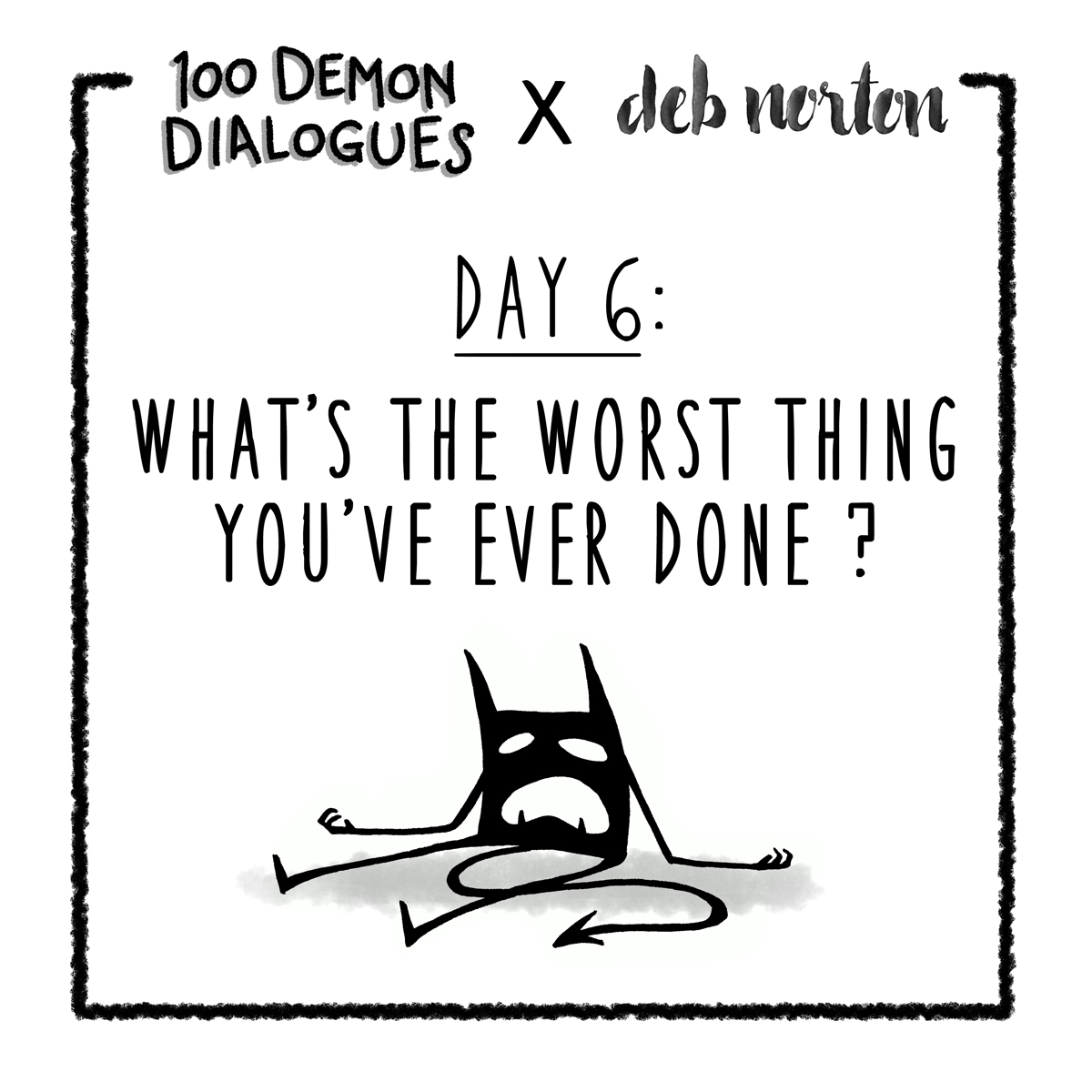
Your Inner Critic is probably all too keen to tell you about the things you’re doing wrong, but about the times they’ve royally screwed up? Take confession in six minutes of free-writing.
If you’re feeling brave and want to share any of your responses to these prompts, you can leave excerpts in the comments below, or email them to me (lucypcbellwood@gmail.com) to be included in an anonymous roundup at the end of the project. The last prompt goes up tomorrow!
If you haven’t done so already, you can listen to a whole conversation about this Creative Resistance stuff in this talk I just recorded with Deb.
NOW GET WRITING!
It’s Day Five of the Inner Critic Investigation series I’m collaborating on with writing coach Deb Norton! Our goal is to help you develop a dialogue with your inner monologue and better understand why your brain keeps trying to stop you from making work.
The rules are as follows:
- Get a pen and a sheet of paper.
- Set a timer for six minutes.
- WRITE. Ask your inner critic the question and find out what they have to say. Keep your pen moving, even if you’re writing lies or “Blah blah blah” over and over.
Here’s today’s prompt:
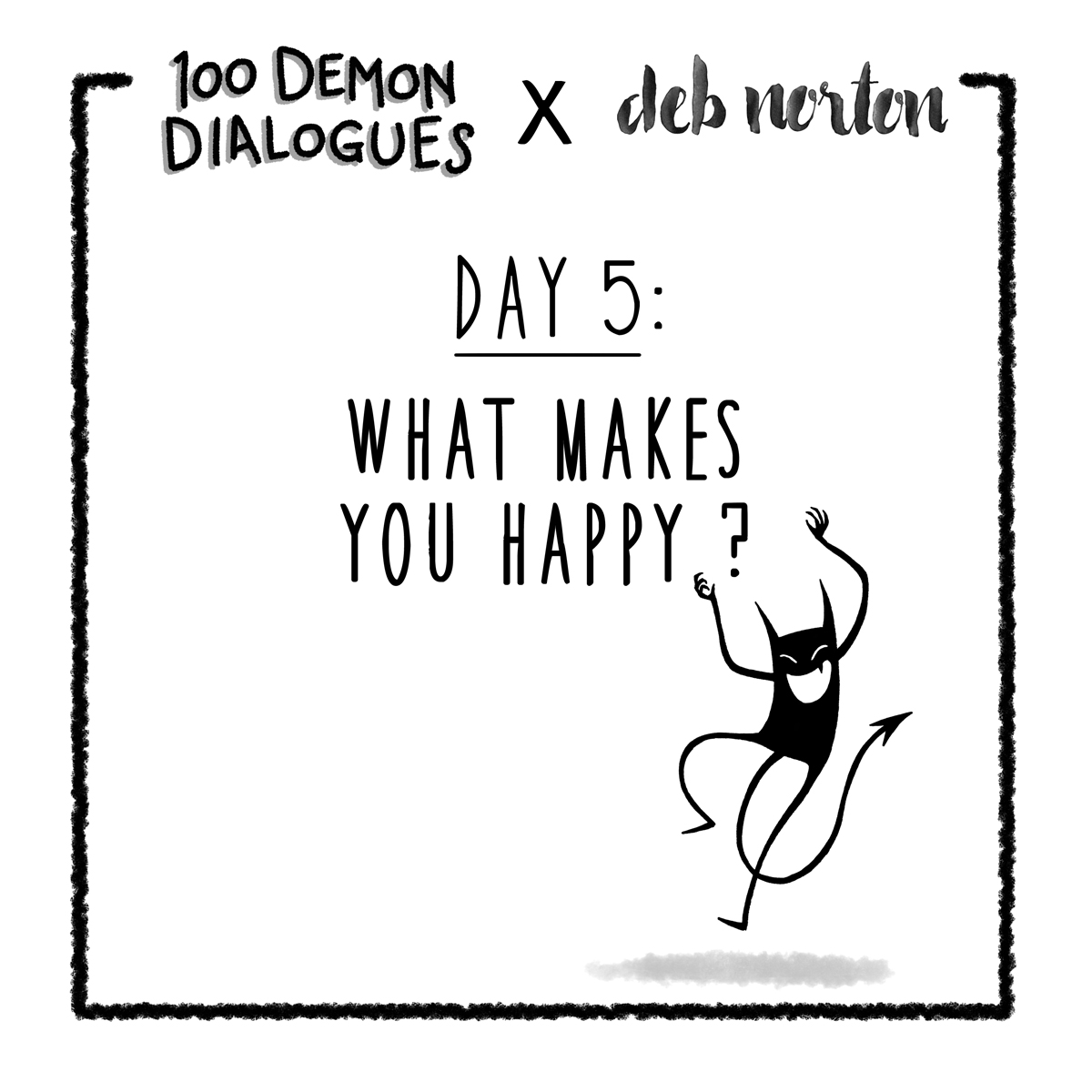
Often our Inner Critics are busy being, well, critical. What makes them truly happy? The knowledge that they’ve successfully protected you from failure. A heaping plate of junk food. Convincing you to do what they want. Shiny pebbles. Getting to see a movie. You can also try moving from the prompt “I’m happiest when you…”
If you’re feeling brave, share your results from these exercises in the comments below, or email them to me (lucypcbellwood@gmail.com) and I can post them anonymously. I would love to have a collection of Critic Quotes at the end of this experiment.
If you want to listen in to a whole conversation about this Creative Resistance stuff, check out this talk I just recorded with Deb.
NOW GET WRITING!
It’s Day Four of the Inner Critic Investigation series I’m collaborating on with writing coach Deb Norton! We’re hoping these prompts can give you all some insight into what your little jerks are thinking and feeling as they go about trying to stop you from making creative work.
The rules are as follows:
- Get a pen and a sheet of paper.
- Set a timer for six minutes.
- WRITE. Ask your inner critic the question and find out what they have to say. Keep your pen moving, even if you’re writing lies or “Blah blah blah” over and over.
Here’s today’s prompt:

The Inner Critic loves to tell us about all the other things in the world that it believes are more important than working on our creative projects, from taking naps to volunteering at the local food bank. Whether it’s trying to tempt you or shame you, write it all out in a list. What does it think you should be doing instead?
There will be a new prompt once per day for the rest of the week. This is a great exercise to do as a warmup before you sit down to tackle your daily NaNoWriMo goal, or just launch into creative work of any nature. There are no wrong answers. Go wild.
If you want to listen in to a whole conversation about this Creative Resistance stuff, check out this talk I just recorded with Deb.
NOW GET WRITING!
It’s Day Three of the Inner Critic Investigation series I’m collaborating on with writing coach Deb Norton! We’re hoping these prompts can give you all some insight into what your little jerks are thinking and feeling as they go about trying to stop you from making creative work.
The rules are as follows:
- Get a pen and a sheet of paper.
- Set a timer for six minutes.
- WRITE. Ask your inner critic the question and find out what they have to say. Keep your pen moving, even if you’re writing lies or “Blah blah blah” over and over.
Here’s the prompt:
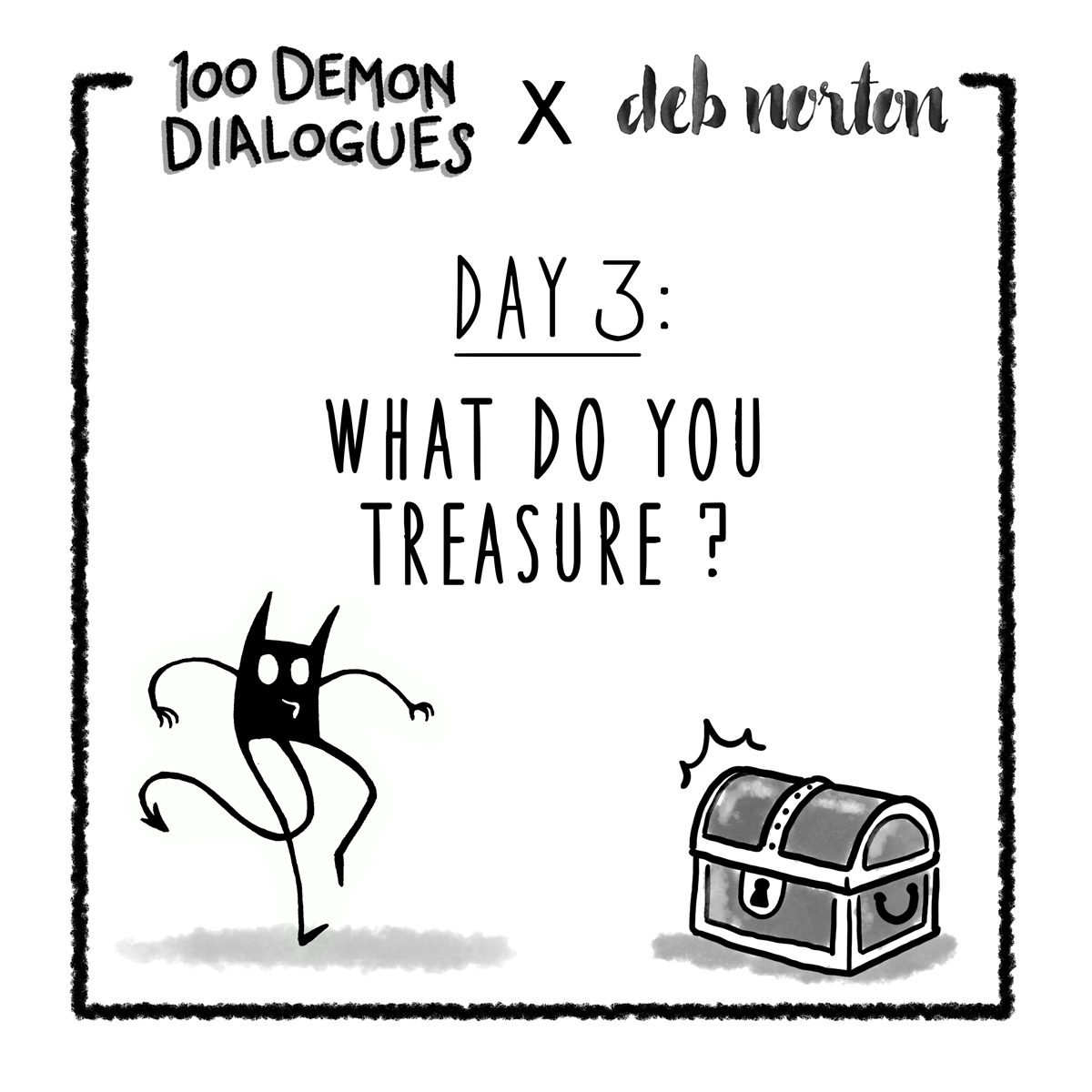 What is precious to your Inner Critic? What do they value above all else? Fame? Security? The knowledge that they’ve successfully prevented you from making a mistake?
What is precious to your Inner Critic? What do they value above all else? Fame? Security? The knowledge that they’ve successfully prevented you from making a mistake?
There will be a new prompt once per day for the rest of the week. This is a great exercise to do as a warmup before you sit down to tackle your daily NaNoWriMo goal, or just launch into creative work of any nature. There are no wrong answers. Go wild.
If you want to listen in to a whole conversation about this Creative Resistance stuff, check out this talk I just recorded with Deb.
NOW GET WRITING!
It’s Day Two of the Inner Critic Investigation series I’m collaborating on with writing coach Deb Norton! We’re hoping these prompts can give you all some insight into what your little jerks are thinking and feeling as they go about trying to stop you from making creative work.
The rules are as follows:
- Get a pen and a sheet of paper.
- Set a timer for six minutes.
- WRITE. Ask your inner critic the question and find out what they have to say. Keep your pen moving, even if you’re writing lies or “Blah blah blah” over and over.
Here’s the prompt:
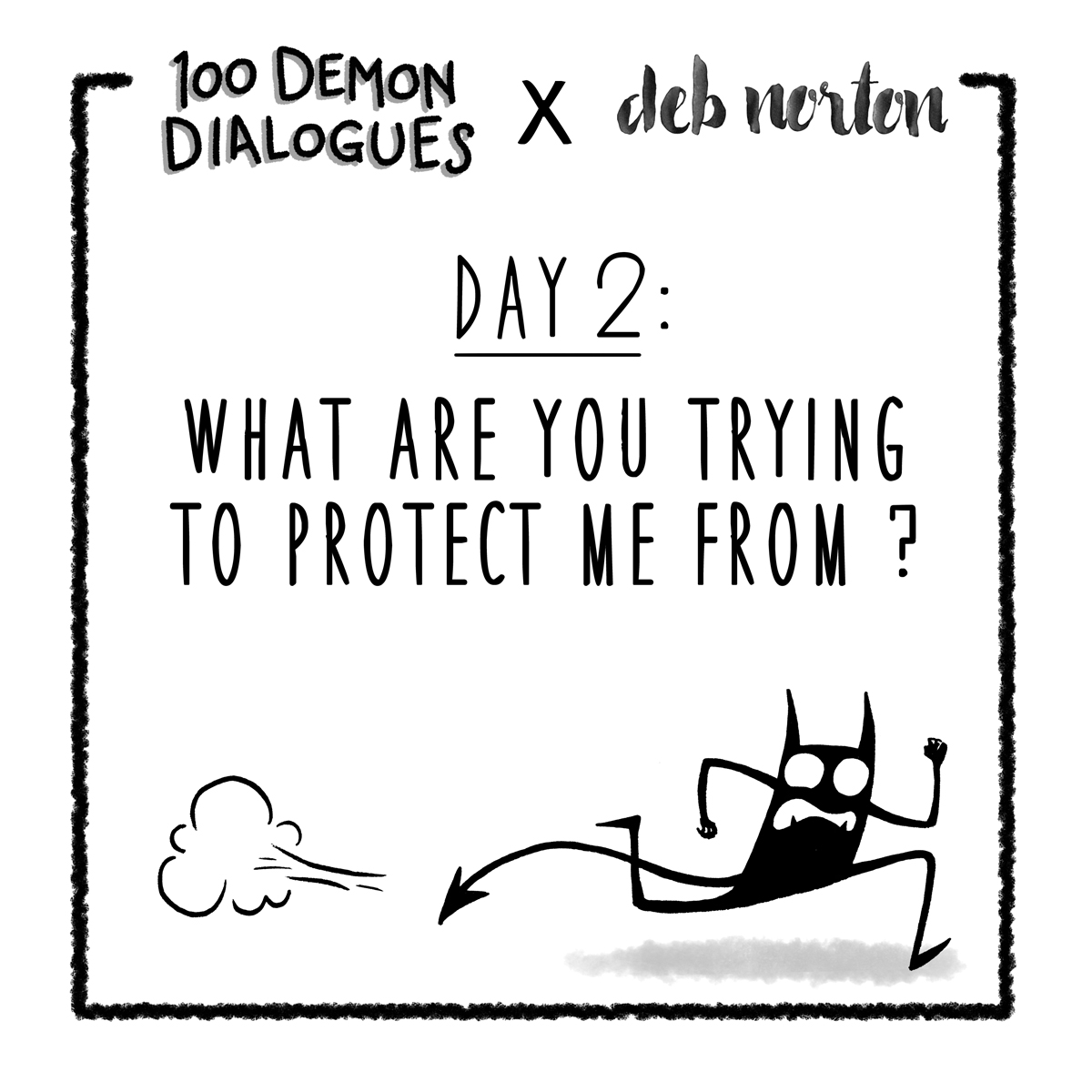
Often our Inner Critics harp on us because they’re scared of what will happen if we try something new. Ask your Inner Critic what’s out there. What could go wrong? What would the consequences be?
There will be a new prompt once per day for the rest of the week. This is a great exercise to do as a warmup before you sit down to tackle your daily NaNoWriMo goal, or just launch into creative work of any nature. There are no wrong answers. Go wild.
If you want to listen in to a whole conversation about this Creative Resistance stuff, check out this talk I just recorded with Deb.
NOW GET WRITING!
This week I’m thrilled to announce the release of my latest podcast episode with writing coach Deb Norton, a long-time friend and extraordinary creative resource.
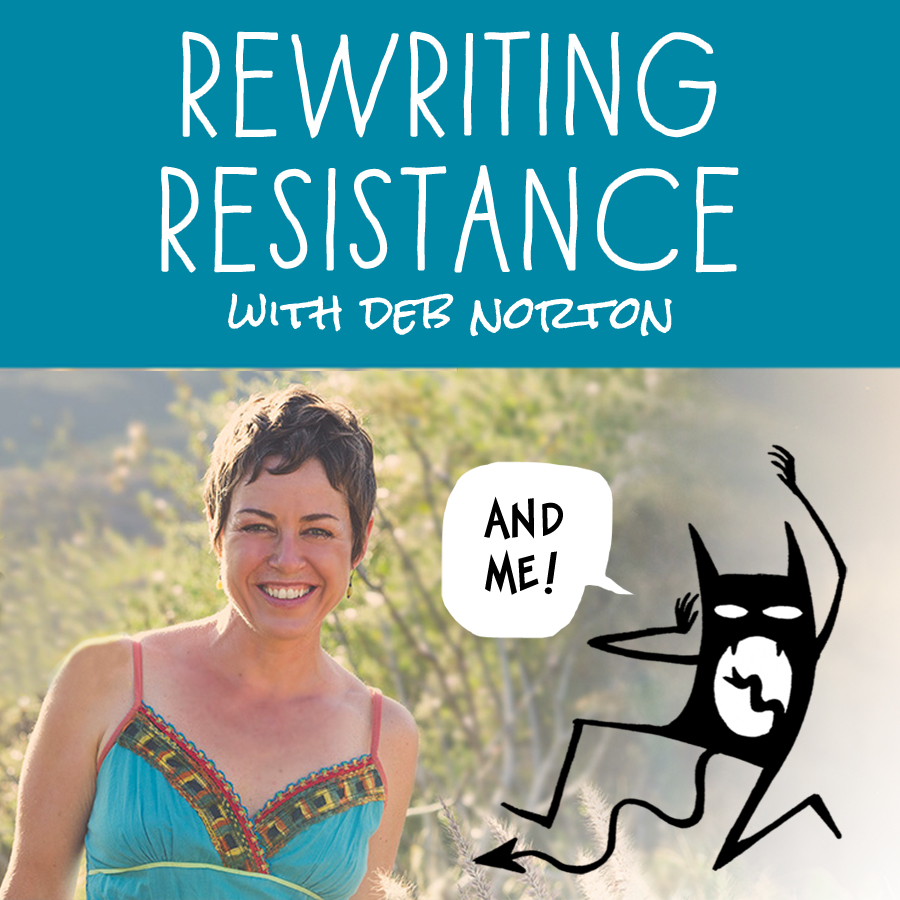
I’ve known Deb since I was 13. She brought me into my first writer’s group and taught me so much about working with my inner critic in the company of other dedicated creators. She was a huge inspiration for the 100 Demon Dialogues project, so I’ve been itching to talk with her for a while. We ended up recording an hour-long conversation about creative resistance, grit, risk-tolerance, accountability, limitations, shame, self-knowledge, protection, NaNoWriMo, recovery, process, and so much more. You can listen to the audio through SoundCloud, or watch the video if you’d rather see us wave our arms while we put everything to rights.
As a fun bonus exercise, we decided to collaborate on a series of seven prompts that will help you get to know your own Inner Critic a little better. The rules are simple: set a timer for 6 minutes and let your demon do the talking. It always wants your attention anyway, so give it the floor and see what happens.You can write lies, you can write truths. Just make a mess.
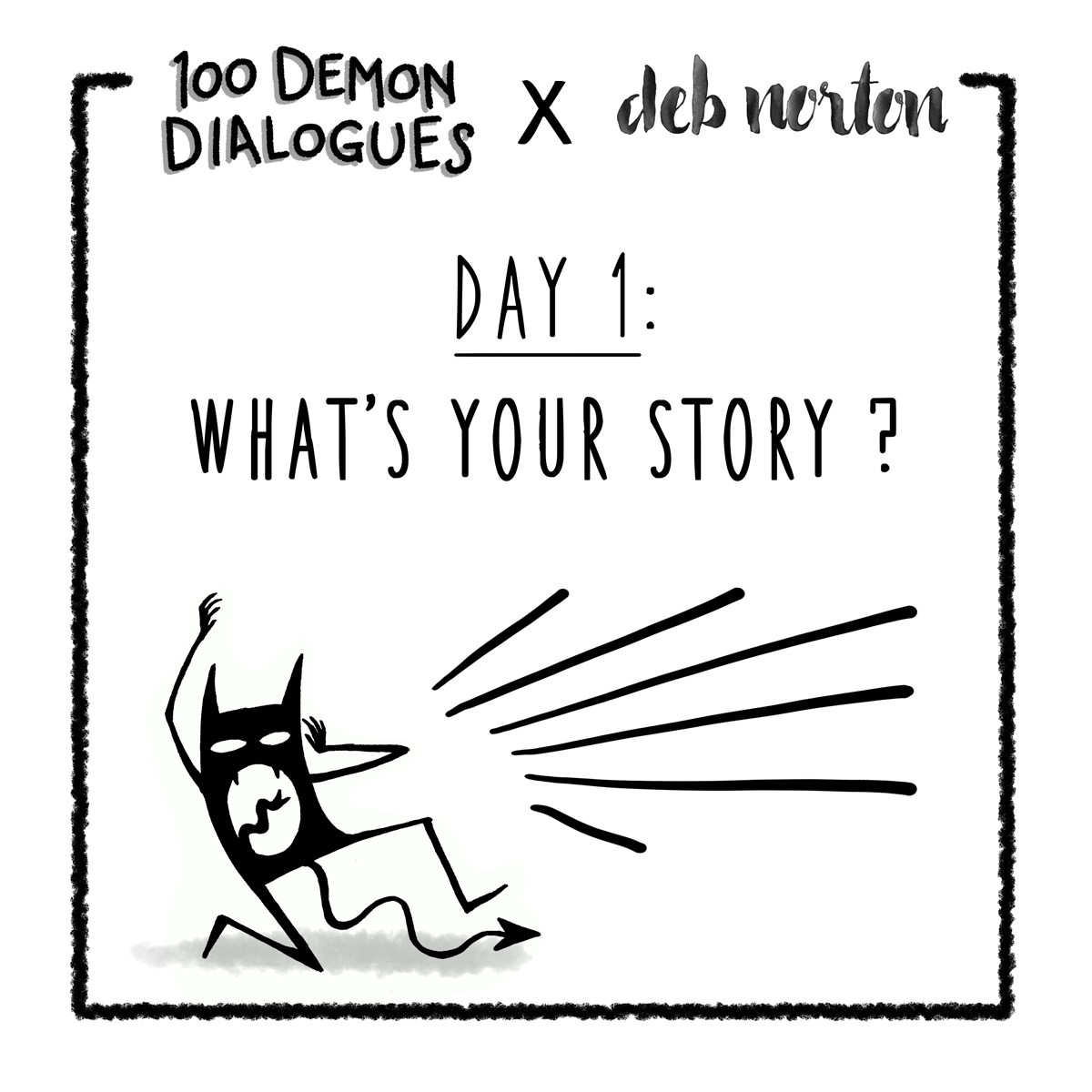
A new prompt will go up at 9am PST every day this week. You can find them on Instagram, Twitter, Tumblr, Patreon, Facebook or via this blog. (Gracious, that’s a lot of social media. Something for everyone, I guess!)
Thanks for reading, and good luck with the prompt! I look forward to hearing what comes up for you all.
Hi friends, I am very excited to announce that I’ll be speaking at Creative Mornings this Friday (October 6th) at 8:30am at the Armory Theater here in Portland.

Creative Mornings is a free monthly lecture series where speakers appear on stages all over the world to deliver thoughts on a communal theme—all before 10am on a Friday. This month’s prompt is PIONEER, and I’ve crafted a talk all about belonging, childhood passions, and curiosity that I am super stoked to reveal.
I’m also hand-drawing all my slides, which has led to working on things like this all week:
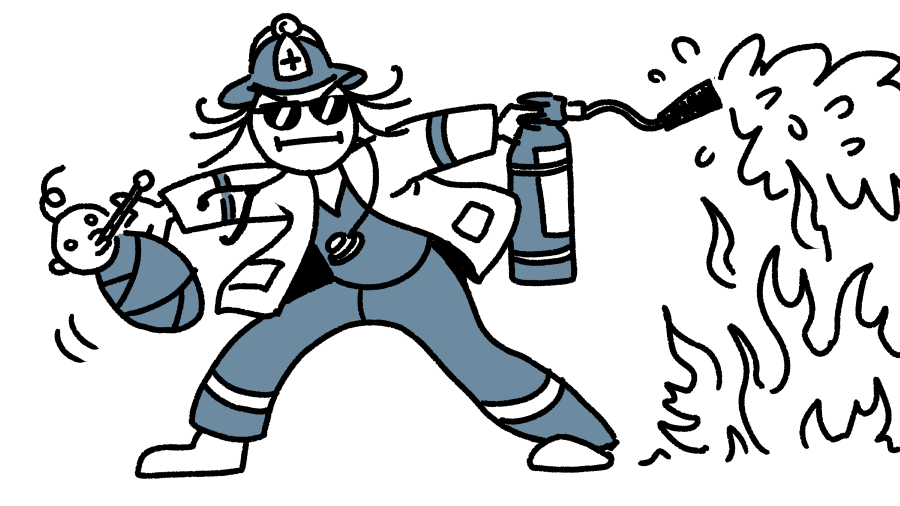
WHAT IS THIS PERSON DOING WITH THAT FIRE EXTINGUISHER AND ALSO THAT BABY? Come to The Armory on Friday to find out.
Seats are free, and the CM Team provide donuts and coffee to get you pepped up in the early hours. All you need to do is reserve a spot through this website. I look forward to seeing you there!








